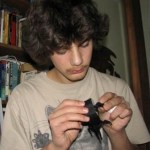
Since this is another one of the recurring themes on my blog, I decided to republish all of my old posts on the topic together under the fold. Since my move here to the new blog, I have continued to write about this, e.g., in the following posts:
Preserving species diversity - long-term thinking
Hot boiled wine in the middle of the winter is tasty....
Global Warming disrupts the timing of flowers and pollinators
Global Warming Remodelling Ecosystems in Alaska
-----------------------------------------------
Clocks, Migration and the Effects of Global Warming (December 23, 2005)
Circadian…
Lars Fischer studied chemistry and now works as a science journalist, blogger at Fischblog and coordinator at the German-language science blogging site scilogs.de (which recently spawned the English-language sister site scilogs.eu). Lars and I spent a lot of time together at the Lindau Nobel meeting where Lars interviewed me and I asked Lars to provide a guest-post for my blog about the main 'take-home' message he got from the conference:
Richard Feynman was 29 when he finally published his works on quantum electrodynamics. At the age of 22, Charles Darwin first set foot on the Beagle, and…
This is the sixth post in a series about mechanism of entrainment, running all day today on this blog. In order to understand the content of this post, you need to read the previous five installments. The original of this post was first written on April 12, 2005.
A Phase Response Curve (PRC) can be made in three ways:
One can construct a PRC for a single individual. If you have a reasonably long-lived organism, you can apply a number of light pulses over a period of time. The advantage is that you will always know the freerunning period of your organism, and you will know with absolute…
Something unpredictable but in the end it's right, I hope you have the time of your life.
- Greenday
First written on March 04, 2005 for Science And Politics, then reposted on February 27, 2006 on Circadiana, a post about a childrens' book and what I learned about it since.
When I was a kid I absolutely loved a book called "Il Ciondolino" by Ricardo Vamba - a book in two slim volumes for kids (how times change - try to publish a 200+ page book of dense text for children today!). I later found out that it was translated into English under the title The Prince And His Ants in 1910 (Luigi BERTELLI (M: 1858 or 1860 - 1920) (&ps: VAMBA) The Prince And His Ants [It-?]. Holt.(tr S F WOODRUFF) […
There are 12 new articles in PLoS ONE today. As always, you should rate the articles, post notes and comments and send trackbacks when you blog about the papers. You can now also easily place articles on various social services (CiteULike, Mendeley, Connotea, Stumbleupon, Facebook and Digg) with just one click. Here are my own picks for the week - you go and look for your own favourites:
Reef Endemism, Host Specificity and Temporal Stability in Populations of Symbiotic Dinoflagellates from Two Ecologically Dominant Caribbean Corals:
The dinoflagellate genus Symbiodinium forms symbioses with…
The series of interviews with some of the participants of the 2008 Science Blogging Conference was quite popular, so I decided to do the same thing again this year, posting interviews with some of the people who attended ScienceOnline'09 back in January.
Today, I asked Djordje Jeremic (yes, he is the son of Tanja Sova), of the Paper Disciple's Blog, to answer a few questions.
Welcome to A Blog Around The Clock. Would you, please, tell my readers a little bit more about yourself? Who are you? Where are you from? What is your interest in science? How about art?
Why thank you! I am Djordje…
This is the fifth post in a series about mechanism of entrainment. Originally written on April 11, 2005.
If you look at the Phase Response Curve you made you see that, as you follow the curve through the 24-hour cycle, you first encounter a dead zone during the subjective day (VT0 - CT 12) during which light pulses exert no or little effect on the phase of the clock. The line, then, turns down (negative slope) into the delay portion of the curve until it reaches a maximal delay in the early night. It reverses its direction then and goes up (positive slope) until it reaches maximal phase-…
Back home after two weeks. Jet-lag will probably hit me tomorrow. Lots of catch-up with PLoS work awaits me tomorrow as well, but blogging should continue afterwards - several more posts about the Belgrade part of the trip are yet to come.
There are 10 new articles published Friday night and 8 new articles published tonight in PLoS ONE. As always, you should rate the articles, post notes and comments and send trackbacks when you blog about the papers. You can now also easily place articles on various social services (CiteULike, Mendeley, Connotea, Stumbleupon, Facebook and Digg) with just one click. Here are my own picks for the week - you go and look for your own favourites:
Aquaculture Enclosures Relate to the Establishment of Feral Populations of Introduced Species:
Many species introduced by humans for social and economic…
The 73rd edition of the Encephalon is up on Channel N
Carnival of the Green #188 is up on Kids Discover Nature
We have recently covered interesting reproductive adaptations in mammals, birds, insects, flatworms, plants and protists. For the time being (until I lose inspiration) I'll try to leave cephalopod sex to the experts and the pretty flower sex to the chimp crew.
In the meantime, I want to cover another Kingdom - the mysterious world of Fungi. And what follows is not just a cute example of a wonderfully evolved reproductive strategy, and not just a way to couple together my two passions - clocks and sex - but also (at the very end), an opportunity to post some of my own hypotheses online.…
The fourth post in the series on entrainment, originally written on April 10, 2005, explains the step-by-step method of constructing a PRC.
After months of applying light pulses to your animals you are ready to analyze and plot your data. You will print out the actographs (see how in the post "On Methodology" in the "Clock Tutorials" category) and you will see many instances of phase-shifts, somewhat like the very last figure in this post.
For each light pulse you applied to each animal, you measure the direction of the phase-shift (i.e., if it was a delay or an advance) and the size of the…
If you spend too much time warming up, you'll miss the race. If you don't warm up at all, you may not finish the race.
- Grand Heidrich
Hypotheses leading to more hypotheses (from March 19, 2006 - the Malaria Day):
I have written a little bit about malaria before, e.g, here and here, but this is my special Malaria Action Day post, inspired by a paper [1] that Tara sent me some weeks ago and I never got to write about it till now.
-------------------------------------------------------------------------------
In a journal called "Medical Hypotheses" Kumar and Sharma [1] propose that jet-lagged travellers may be more susceptible to getting infected with malaria. They write:
Rapid travel across several time zones leads to…
The third post in the series on entrainment, first written on April 10, 2005, starts slowly to get into the meat of things...As always, clicking on the spider-clock icon will take you to the site of the original post.
In the previous post, I introduced the concept of entrainment of circadian rhythms to environmental cycles. As I stated there, I will focus on non-parametric effects of light (i.e., the timing of onsets and offsets of light) on the phase and period of the clock.
Entrainment is a mechanism that forces the internal period (&tau - tau) of the biological clock to assume the…
One of the things which danger does to you after a time is, well, to kill emotion. I don't think I shall ever feel anything again except fear. None of us can hate anymore - or love.
- Graham Greene
This post is perhaps not my best post, but is, by far, my most popular ever. Sick and tired of politics after the 2004 election I decided to start a science-only blog - Circadiana. After a couple of days of fiddling with the templae, on January 8, 2005, I posted the very first post, this one, at 2:53 AM and went to bed. When I woke up I was astonished as the Sitemeter was going wild! This post was linked by BoingBoing and later that day, by Andrew Sullivan. It has been linked by people ever since, as recently as a couple of days ago, although the post is a year and a half old.…
This is the second in a series of posts on the analysis of entrainment, originally written on April 10, 2005.
The natural, endogenous period of circadian rhythms, as measured in constant conditions, is almost never exactly 24 hours. In the real world, however, the light-dark cycle provided by the Earth's rotation around its axis is exactly 24 hours long. Utility of biological clocks is in retaining a constant phase between environmental cycles and activities of the organism (so the organism always "does" stuff at the same, most appropriate time of day).
Thus, a mechanism must exist to…

